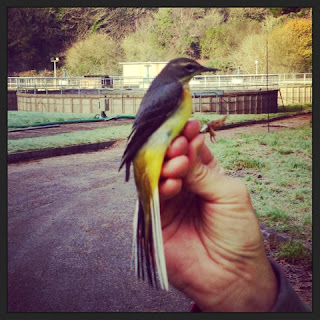Below Kester writes a quick summary of a reasonable autumn in Penwith:
As the mornings get ever more chilly and bird
numbers start to dry up, thoughts of packing up the nets at Nanjizal for the winter
pop into my head. The late autumn movements of thrushes and finches
didn't seem to happen this year, with very low numbers flying over in
the first few hours of light. Using a Redwing recording has boosted catches in the last few weeks, but
Blackbirds that are usually so numerous in November are altogether missing. Chiffchaff catches remain low, as have Goldcrest and Firecrest, but one warbler caught in higher numbers than usual, mirroring the massive UK arrival, was Yellow-browed Warbler. Up until today, 15 birds
have been caught, including an impressive five on 10th November alone! Other birds of note recently
were a Dusky Warbler caught on 7th November and a very good candidate for a
halimodendri Lesser Whitethroat on 13th November.
 |
| Dusky Warbler |
 |
| Halimodendri Lesser Whitethroat |
 |
| Tailt moult such as this in first-year halimodendri is actually rather common. |
Interestingly, the DNA from this Lesser Whitethroat trapped in early October at Nanijzal came back as being of the race
blythi.
 |
| Blythi Lesser Whitethroat |
And just to add to the mix, going back to 20th October
2000, the bird below was caught. Unfortunately, a feather for DNA analysis doesn't exist, so we may never know what it really was. However, whilst its warm upperparts may suggest
blythi, this was a big bird, with a tail length
of 65mm, and a very 'blunt' wing. Birds from Mongolia very much resembling this bird have been DNA-tested and identified as being of the race
margelenica.
 |
| Margelenica Lesser Whitethroat? |
Some interesting controls from the autumn were:
- Juvenile Chiffchaff ringed at Nanjizal on 14/7/20113, recaught at Squire's Down (Dorset) on 21/9/2013
- Young male Firecrest ringed on St
Agnes (Isles of Scilly) on 21/10/2012, recaught at Nanjizal on 5/10/2013
- Young Sedge Warbler ringed at Nanjizal on 3/9/2013, found dead the next day at St Ives
So with nets now down for the autumn, some of the notable ringing totals include a top five of:
- Chiffchaff - 701
- Blackcap - 588
- Sedge Warbler - 538
- Chaffinch - 244
- Willow Warbler - 165
impressive totals of:
- Grasshopper Warbler - 54
- Yellow-browed Warbler - 15
- Firecrest - 10
and some rarities:
- Subalpine Warbler - 2
- Wryneck
- Aquatic Warbler
- Marsh Warbler
- Dusky Warbler
- Cirl Bunting



















